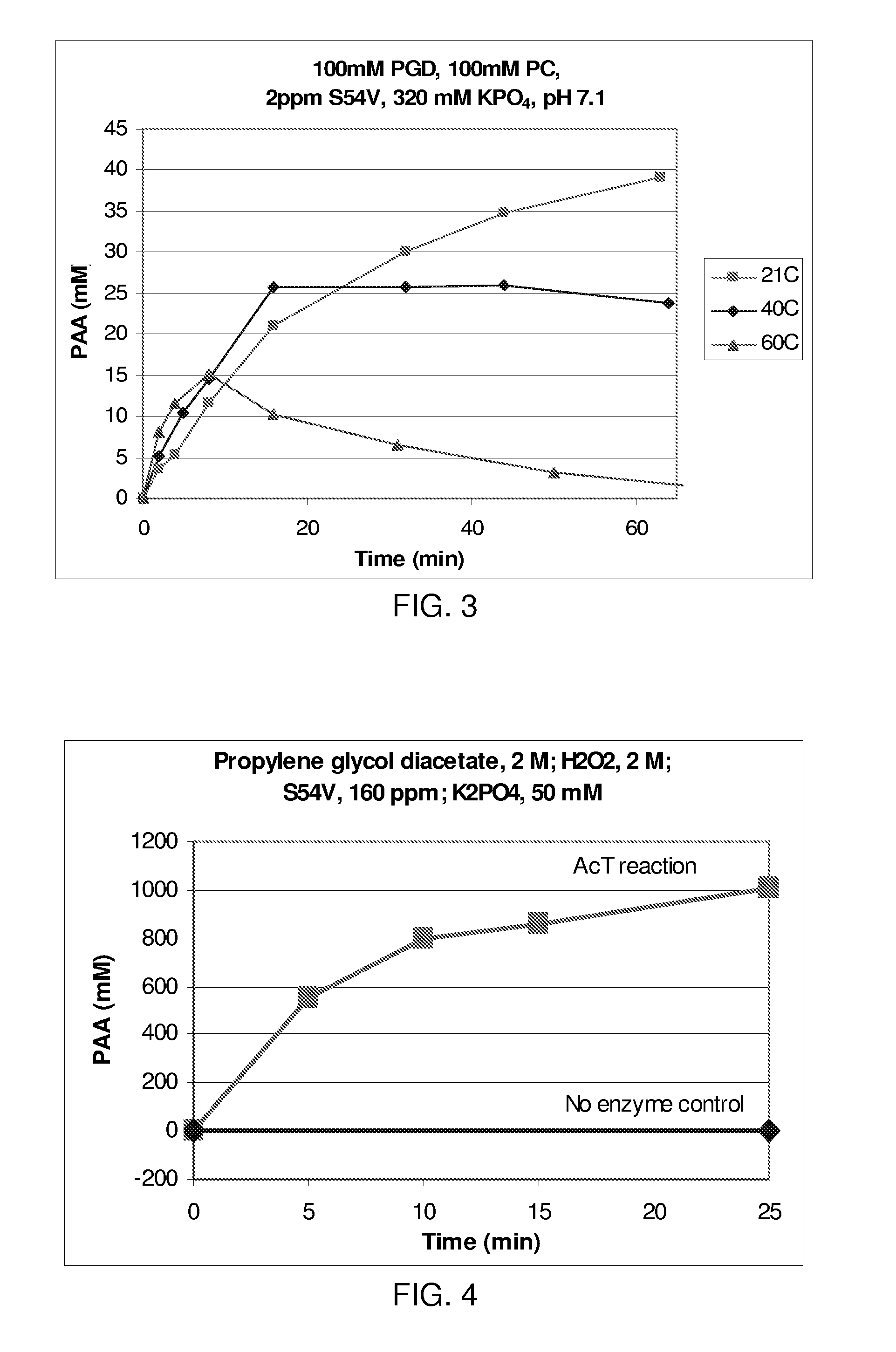Stable Enzymatic Peracid Generating Systems
a technology of enzymatic peracid and generating system, which is applied in the field of stable compositions, can solve the problems of large chemical “footprint”, relatively few disposal problems, and large chemical footprint of paa
- Summary
- Abstract
- Description
- Claims
- Application Information
AI Technical Summary
Benefits of technology
Problems solved by technology
Method used
Image
Examples
example 1
Killing Curve for B. subtilis Spores by Peracetic Acid (PAA)
[0195]In this Example, experiments conducted to determine the killing curve of peracetic acid (PAA) and PAA in conjunction with detergent (commercially available PUREX® [Dial] was used in this Example) for B. subtilis spores. In these experiments, the B. subtilis spores were prepared as known in the art (See e.g., Siccardi et al., J. Bacteriol., 121:13-19 [1975]). Assays were carried out in duplicate in 96-well, round bottomed microtiter plates (Costar) with peracetic acid (32 wt % in acetic acid; Aldrich). The PAA was serially diluted in either 50 mM KPO4 buffer, pH 7.1 (“Buffer”), or in a 1:500 dilution of Purex (original formula; Dial) in the same buffer (“Buffer+Det”) in a total volume of 50 μl. The amount of PAA added to the assay was 0, 0.4, 4 or 40 mM. A volume of 5 μl of the spore suspension, containing 109-1010 spores, was then added to each well and the assay incubated for 15 min at RT. Ice cold LB (150 μl) (See e...
example 2
Enzymatic Generation of PAA
[0196]In this Example, three methods for generation of PAA by acyl transferase are described. In one method, at least one acyl transferase (wild-type or variant) is combined with at least one ester substrate, and hydrogen peroxide in a buffer or detergent, with or without one or more surfactants. In an alternative method, at least one acyl transferase (wild-type or variant), at least one ester substrate, and sodium percarbonate (or other source of H2O2) are combined in a buffer or detergent, with or without one or more other surfactants. In yet a further method, at least one acyl transferase (wild-type or variant) is combined with glucose oxidase and glucose, in a concentration sufficient to generate an amount of PAA with which to kill spores in buffer or detergent. In some formulations, one or more other surfactants are also included. Other enzymes that generate H2O2 also find use in this system, including oxidases, oxidoreductases (e.g., glyerol oxidase ...
example 3
Enzymatic Generation of PAA Kills B. subtilis Spores
[0203]In this Example, experiments conducted to assess the killing ability of enzymatically generated PAA tested with B. subtilis spores are described. Based on the results obtained in the experiments described in Examples 1 and 2, a range of 4 to 40 mM PAA was determined to be sufficient to demonstrate killing of spores of B. subtilis 1-168. In these experiments, spore killing was assessed in buffer, as well as in detergent.
[0204]Spore Killing in Buffer
[0205]In this experiment, sodium percarbonate was used as the source of H2O2. The final solution contained: 100 mM 1,2-propylene glycol diacetate, 2 ppm S54V variant, 39 mM sodium percarbonate (Technical grade 85%; yielding 100 mM effective H2O2) in 320 mM KPO4 pH 7.1 in a total volume of 800 μl. This mix (yield 40 mM PAA) was serially diluted to give additional mixes that yielded 4.9, 9.9 and 20.5 mM PAA. A mix with only 400 mM KPO4 pH 7.1 was used to determine total spore counts i...
PUM
| Property | Measurement | Unit |
|---|---|---|
| time | aaaaa | aaaaa |
| pH | aaaaa | aaaaa |
| pH | aaaaa | aaaaa |
Abstract
Description
Claims
Application Information
 Login to View More
Login to View More - R&D
- Intellectual Property
- Life Sciences
- Materials
- Tech Scout
- Unparalleled Data Quality
- Higher Quality Content
- 60% Fewer Hallucinations
Browse by: Latest US Patents, China's latest patents, Technical Efficacy Thesaurus, Application Domain, Technology Topic, Popular Technical Reports.
© 2025 PatSnap. All rights reserved.Legal|Privacy policy|Modern Slavery Act Transparency Statement|Sitemap|About US| Contact US: help@patsnap.com


